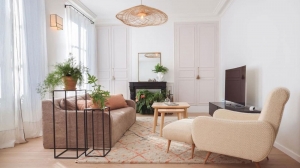If you’ve ever walked into a room filled with clutter, stacks of papers, tangled cords, clothes you “might wear someday”, you know how quickly it can overwhelm your mind. On the flip side, stepping into a clean, open, and intentionally organized space can instantly lower stress and lift your mood.
Even for those browsing Scripps Ranch homes for sale in search of a new environment, the truth is that peace of mind often comes less from where you live and more from how you live in your space. Minimalist living isn’t about owning less for the sake of austerity, it’s about clearing space for clarity, creativity, and calm.
Let’s explore how reducing clutter can boost your mental health, productivity, and overall sense of balance.
The Psychology Of Clutter
Clutter is more than just a visual nuisance, it’s a mental load. When your environment is chaotic, your brain has to process more stimuli, making it harder to focus or relax.
According to the Princeton University Neuroscience Institute, physical clutter competes for your attention, leading to decreased performance and increased stress. In simple terms, every out-of-place item acts like a tiny notification pinging your brain, constantly reminding you of what’s unfinished or out of control.
Over time, this visual noise can raise cortisol (the stress hormone), drain your energy, and even affect sleep quality. By removing unnecessary items, you remove mental “background noise,” allowing your mind to rest and reset.
Minimalism Isn’t Deprivation – It’s Intentional Living
A common misconception about minimalism is that it’s about getting rid of everything. In reality, it’s about curating your environment so that everything you keep serves a purpose or brings joy.
Minimalist living is less about counting possessions and more about making conscious choices:
- Choosing quality over quantity.
- Prioritizing experiences over objects.
- Keeping what supports your goals and well-being.
When your surroundings reflect your values, you feel more aligned, and less distracted by things that no longer serve you.
It’s not about having an empty house; it’s about creating a home that feels full of peace.
The Emotional Weight Of “Stuff”
Our belongings often carry emotional stories, gifts we feel guilty discarding, clothes tied to past identities, or sentimental keepsakes. Letting go can feel like losing a part of ourselves.
But minimalism encourages you to reframe that attachment. You’re not erasing memories; you’re making room for new ones.
Psychologists suggest a powerful method: the one-minute rule. If you can tidy or decide on an item in under a minute, do it immediately. This prevents buildup and rewires your brain to see order as effortless, not overwhelming.
You can also use the “joy or function” test, if something doesn’t make you happy or serve a real purpose, it’s time to release it.
The relief that comes after decluttering isn’t just physical, it’s deeply emotional.
Space, Light, And Mental Clarity

Minimalist spaces aren’t only cleaner; they’re often brighter, calmer, and more spacious, all of which promote positive psychological effects.
Natural light, neutral tones, and open layouts give your eyes (and mind) room to rest. These features are not limited to luxury homes; anyone can create them with simple choices:
- Open blinds to maximize sunlight.
- Use mirrors to expand small spaces.
- Choose soft, natural colors to calm the senses.
- Limit furniture and décor to essentials that inspire ease.
A 2020 study from UCLA’s Center on Everyday Lives of Families found that women who described their homes as “cluttered” had higher stress levels and lower mood throughout the day. Creating simplicity, even in one room, can have measurable emotional benefits.
The Minimalist Routine: Small Steps, Big Changes
You don’t have to transform your entire home overnight. Minimalism thrives on gradual consistency.
Here’s a simple weekly structure to start decluttering without burnout:
- Monday: Tackle a drawer or small surface (like your desk).
- Wednesday: Declutter a digital space, inbox, photos, or apps.
- Friday: Donate one bag of items or recycle what’s unused.
- Sunday: Reflect on how your space feels after each change.
As you build this rhythm, you’ll start to notice something subtle, it’s not just your home that feels lighter; it’s you.
Digital Minimalism: Decluttering The Invisible
Minimalism doesn’t stop at the physical world. Our devices, phones, tablets, laptops, are often as cluttered as our closets.
Digital overwhelm can have similar mental effects as visual clutter. Endless notifications, crowded home screens, and messy folders create constant low-level anxiety.
Try these quick digital cleanups:
- Unsubscribe from email lists you never open.
- Organize files into clear folders.
- Turn off non-essential notifications.
- Set “digital curfews” to give your mind time to rest.
These small actions reclaim mental space and help you feel more present in the physical world.
Living Lighter, Thinking Clearer
Minimalism is ultimately an act of self-care. By simplifying your surroundings, you’re sending your brain a signal that says: you’re safe, you’re supported, you can focus on what matters.
Even if your next chapter includes exploring Scripps Ranch homes for sale for a fresh start, the key isn’t in square footage, it’s in creating a lifestyle that nurtures your mental peace.
As you release what no longer serves you, physically, emotionally, and digitally, you gain something far more valuable: clarity.
Because when your space breathes, you do too.






